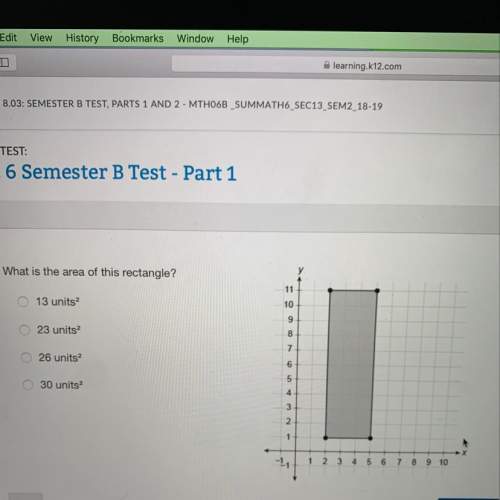
Mathematics, 29.08.2019 19:20 kwoolfe59006
Consider the function f(x)=x+9√−3f(x)=x+9−3 on the domain [−9,[infinity])[−9,[infinity]). the inverse of this function is f−1(x)=x2+6xf−1(x)=x2+6x. a: what is the domain of f−1f−1? b: why must the domain of f−1f−1 be restricted?

Answers: 3


Another question on Mathematics


Mathematics, 21.06.2019 16:20
Refer to interactive solution 17.45 to review a method by which this problem can be solved. the fundamental frequencies of two air columns are the same. column a is open at both ends, while column b is open at only one end. the length of column a is 0.504 m. what is the length of column b?
Answers: 1

Mathematics, 21.06.2019 18:40
Juliana says that she can use the patterns of equivalent ratios in the multiplication table below to write an infinite number of ratios that are equivalent to 6: 10. which statement explains whether juliana is correct? she is correct because she can multiply 6 and 10 by any number to form an equivalent ratio. she is correct because 6: 10 can be written as 1: 2 and there are an infinite number of ratios for 1: 2. she is not correct because the multiplication table does not include multiples of 10. she is not correct because 6: 10 is equivalent to 3: 5 and there are only 9 ratios in the multiplication table that are equivalent to 3: 5.
Answers: 1

Mathematics, 21.06.2019 19:00
Find the equation of the line with slope =8 and passing through (6,53) write your equation in the form y=mx+b
Answers: 1
You know the right answer?
Consider the function f(x)=x+9√−3f(x)=x+9−3 on the domain [−9,[infinity])[−9,[infinity]). the invers...
Questions

Mathematics, 16.12.2020 22:00




Mathematics, 16.12.2020 22:00


Mathematics, 16.12.2020 22:00

Biology, 16.12.2020 22:00

Mathematics, 16.12.2020 22:00


Chemistry, 16.12.2020 22:00

Mathematics, 16.12.2020 22:00


Mathematics, 16.12.2020 22:00

Mathematics, 16.12.2020 22:00

Physics, 16.12.2020 22:00

Physics, 16.12.2020 22:00

Health, 16.12.2020 22:00

Social Studies, 16.12.2020 22:00


 )
)


![f^{-1}(x)=[-3,[tex]\infty)](/tpl/images/0209/5907/337bf.png)



